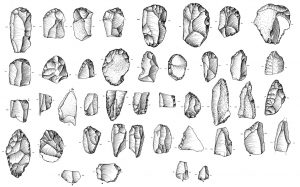01 Oct Scientific drawings of lithics
Documentation of lithics by drawing has been developing since last almost two hundred years. In the case of the oldest drawings, a volume of lithics was depicted by an artistic shading, later by a dense hatching (see e.g. Absolon 1935). In the period after the WW2 a hatching became less dense and also some basic rules of scientific drawing of lithics were established. As a good example from this period, e. g. the drawings made by B. Klíma can be mentioned (Klíma 1956). During last decades, some authors have completely abandoned hatching and directions of detachment of previous flakes are marked out by arrows, if at all (see e.g. Vencl et al., 2006). However, hatching serves also for a depiction of an artefact volume, therefore when it is missing, an aesthetic level of a drawing declines. Rules of the technical scientific drawing of lithics are at least briefly described in all basic manuals in archaeology devoted to the lithic artefacts (e.g. Andrefsky 2005). There are also several papers devoted exclusively to this topic, such as an article by Z. Nerudová (Nerudová, 2004).
In a frame of the scientific documentation of lithic the ERCA Centre offers a drawing up of pen-and-ink drawings of artefacts, which can include a drawing of a dorsal side of the artefact, in a case of ventral retouch also of a ventral side, and a drawing of both (longitudinal and transverse) sections. When necessary, it is possible to add also side views. In a case of cores, a view of a frontal core side is always included, as well as both sections. Other views are conducted if it is necessary. During following computer processing, other auxiliary symbols (arrows in a case of burins or impacts, dots at a place of a bulb, breaks, gloss etc.) are added. Finally, the particular artifacts are folded into clearly arranged tables ready for a publication. Drawings of lithic artefacts can be ordered together with raw material determination and technological and typological analysis of the stone knapped industry.
Technical drawing documentation is in the ERCA Centre covered by Ondřej Mlejnek (born 1982), who cooperates with a draughtsman Lubomíra Dvořáková. Results of their work have been recently published for example in the papers concerning the Palaeolithic occupation of central Moravia (Mlejnek, 2015; Mlejnek et al., 2015), or the Aurignacian collection of lithics from Hlinsko near Lipník (Mlejnek, 2020).
Literatura:
Absolon, K. 1935: Otaslavice, eine neue, große palaeolithische Station in Mähren mit Quarzit-Aurignacien: Versuch einer systematisch-typologischen Bestimmung der Steinartefakte. Brünn.
Andrefsky, W., Jr. 2005: Lithics. Macroscopic Approaches to Analysis, Second Edition.
Cambridge Manuals in Archaeology. Cambridge.
Klíma, B., 1956: Statistická metoda – pomůcka při hodnocení paleolitických kamenných industrií. Návrh české terminologie mladopaleolitických kamenných nástrojů. Památky archeologické 47. 193-210.
Mlejnek, O. 2015: Paleolit východních svahů Drahanské vrchoviny. Dissertationes Archaeologicae Brunenses/Pragensesque 18. Brno.
Mlejnek, O. 2020: Zpráva o záchranném výzkumu mladopaleolitického sídliště v Hlinsku u Lipníka nad Bečvou. Přehled výzkumů 61-1.
Mlejnek, O., Škrdla, P., Přichystal, A. 2012: Ondratice I/Želeč – An Early Upper Palaeolithic Site in Central Moravia, Archäologisches Korrespondenzblatt 42/3, 295-314.
Nerudová, Z. 2004: Způsoby dokumentace kamenné štípané industrie. Sborník prací Filozofické fakulty Brněnské univerzity M 8-9, 53-64.
Vencl. S. a kolektiv, 2006: Nejstarší osídlení jižních Čech. Archeologický ústav AV ČR, Praha.

Example of the older style of the lithic drawings with a dense hatching, which was in use in the first half of the 20th century.

Example of a current style of the lithic domumentation. Drawings by L. Dvořáková, sorted by O. Mlejnek.





